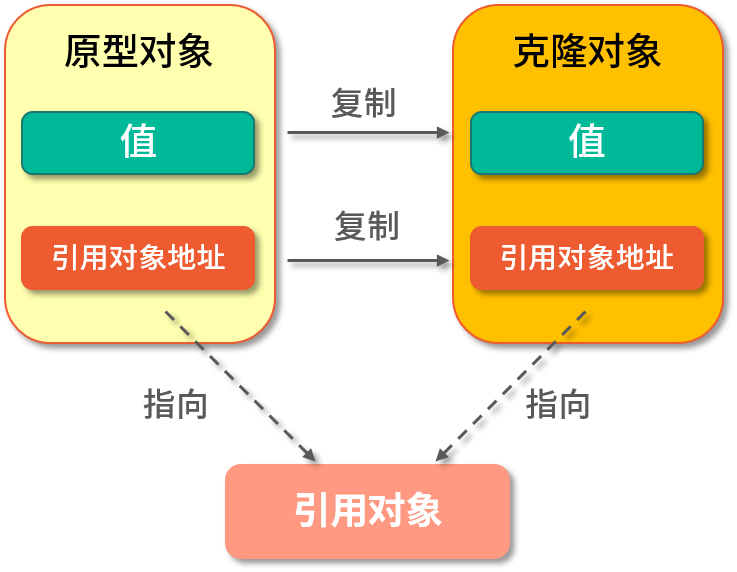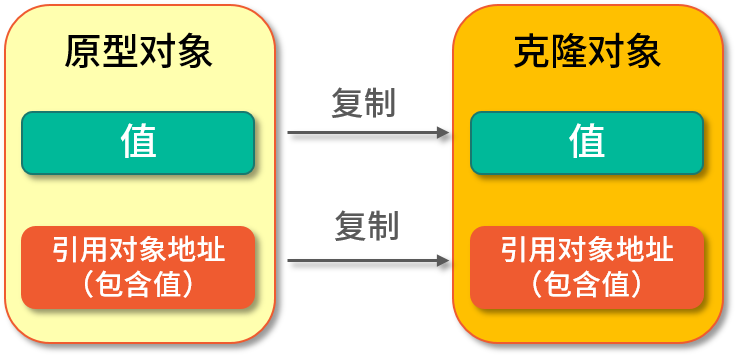使用克隆可以为我们快速地构建出一个已有对象的副本,它属于 Java 基础的一部分,也是面试中常被问到的知识点之一。
我们本课时的面试题是,什么是浅克隆和深克隆?如何实现克隆?
典型回答
浅克隆(Shadow Clone)是把原型对象中成员变量为值类型的属性都复制给克隆对象,把原型对象中成员变量为引用类型的引用地址也复制给克隆对象,也就是原型对象中如果有成员变量为引用对象,则此引用对象的地址是共享给原型对象和克隆对象的。
简单来说就是浅克隆只会复制原型对象,但不会复制它所引用的对象,如下图所示:

深克隆(Deep Clone)是将原型对象中的所有类型,无论是值类型还是引用类型,都复制一份给克隆对象,也就是说深克隆会把原型对象和原型对象所引用的对象,都复制一份给克隆对象,如下图所示:

在 Java 语言中要实现克隆则需要实现 Cloneable 接口,并重写 Object 类中的 clone() 方法,实现代码如下:
public class CloneExample {
public static void main(String[] args) throws CloneNotSupportedException {
// 创建被赋值对象
People p1 = new People();
p1.setId(1);
p1.setName("Java");
// 克隆 p1 对象
People p2 = (People) p1.clone();
// 打印名称
System.out.println("p2:" + p2.getName());
}
static class People implements Cloneable {
// 属性
private Integer id;
private String name;
/**
* 重写 clone 方法
* @throws CloneNotSupportedException
*/
@Override
protected Object clone() throws CloneNotSupportedException {
return super.clone();
}
public Integer getId() {
return id;
}
public void setId(Integer id) {
this.id = id;
}
public String getName() {
return name;
}
public void setName(String name) {
this.name = name;
}
}
}
以上程序执行的结果为:
p2:Java
考点分析
克隆相关的面试题不算太难,但因为使用频率不高,因此很容易被人忽略,面试官通常会在一面或者二面的时候问到此知识点,和它相关的面试题还有以下这些:
- 在 java.lang.Object 中对 clone() 方法的约定有哪些?
- Arrays.copyOf() 是深克隆还是浅克隆?
深克隆的实现方式有几种? - Java 中的克隆为什么要设计成,既要实现空接口 Cloneable,还要重写 Object 的 clone() 方法?
知识扩展
clone() 源码分析
要想真正的了解克隆,首先要从它的源码入手,代码如下:
/**
* Creates and returns a copy of this object. The precise meaning
* of "copy" may depend on the class of the object. The general
* intent is that, for any object {@code x}, the expression:
* <blockquote>
* <pre>
* x.clone() != x</pre></blockquote>
* will be true, and that the expression:
* <blockquote>
* <pre>
* x.clone().getClass() == x.getClass()</pre></blockquote>
* will be {@code true}, but these are not absolute requirements.
* While it is typically the case that:
* <blockquote>
* <pre>
* x.clone().equals(x)</pre></blockquote>
* will be {@code true}, this is not an absolute requirement.
* <p>
* By convention, the returned object should be obtained by calling
* {@code super.clone}. If a class and all of its superclasses (except
* {@code Object}) obey this convention, it will be the case that
* {@code x.clone().getClass() == x.getClass()}.
* <p>
* By convention, the object returned by this method should be independent
* of this object (which is being cloned). To achieve this independence,
* it may be necessary to modify one or more fields of the object returned
* by {@code super.clone} before returning it. Typically, this means
* copying any mutable objects that comprise the internal "deep structure"
* of the object being cloned and replacing the references to these
* objects with references to the copies. If a class contains only
* primitive fields or references to immutable objects, then it is usually
* the case that no fields in the object returned by {@code super.clone}
* need to be modified.
* <p>
* ......
*/
protected native Object clone() throws CloneNotSupportedException;
从以上源码的注释信息中我们可以看出,Object 对 clone() 方法的约定有三条:
- 对于所有对象来说,x.clone() !=x 应当返回 true,因为克隆对象与原对象不是同一个对象;
- 对于所有对象来说,x.clone().getClass() == x.getClass() 应当返回 true,因为克隆对象与原对象的类型是一样的;
- 对于所有对象来说,x.clone().equals(x) 应当返回 true,因为使用 equals 比较时,它们的值都是相同的。
除了注释信息外,我们看 clone() 的实现方法,发现 clone() 是使用 native 修饰的本地方法,因此执行的性能会很高,并且它返回的类型为 Object,因此在调用克隆之后要把对象强转为目标类型才行。
Arrays.copyOf()
如果是数组类型,我们可以直接使用 Arrays.copyOf() 来实现克隆,实现代码如下:
int[] o1 = {1,2,3};
int[] o2 = Arrays.copyOf(o1, o1.length);
// 修改原型对象的第一个元素的值
o1[0] = 2;
System.out.println( Arrays.toString(o1));
System.out.println(Arrays.toString(o2));
以上程序的执行结果为:
[2, 2, 3]
[1, 2, 3]
从结果可以看出,我们在修改原来对象的第一个元素之后,克隆对象的第一个元素没变,这说明 Arrays.copyOf() 其实是一个深克隆。
jdk1.8之前是浅克隆。
深克隆实现方式汇总
深克隆的实现方式有很多种,大体可以分为以下几类:
- 所有对象都实现克隆方法;
- 通过构造方法实现深克隆;
- 使用 JDK 自带的字节流实现深克隆;
- 使用第三方工具实现深克隆,比如 Apache Commons Lang;
- 使用 JSON 工具类实现深克隆,比如 Gson、FastJSON 等。
接下来我们分别来实现以上这些方式,在开始之前先定义一个公共的用户类,代码如下:
/**
* 用户类
*/
public class People {
private Integer id;
private String name;
private Address address; // 包含 Address 引用对象
// 忽略构造方法、set、get 方法
}
/**
* 地址类
*/
public class Address {
private Integer id;
private String city;
// 忽略构造方法、set、get 方法
}
可以看出在 People 对象中包含了一个引用对象 Address。
1.所有对象都实现克隆
这种方式我们需要修改 People 和 Address 类,让它们都实现 Cloneable 的接口,让所有的引用对象都实现克隆,从而实现 People 类的深克隆,代码如下:
public class CloneExample {
public static void main(String[] args) throws CloneNotSupportedException {
// 创建被赋值对象
Address address = new Address(110, "北京");
People p1 = new People(1, "Java", address);
// 克隆 p1 对象
People p2 = p1.clone();
// 修改原型对象
p1.getAddress().setCity("西安");
// 输出 p1 和 p2 地址信息
System.out.println("p1:" + p1.getAddress().getCity() +
" p2:" + p2.getAddress().getCity());
}
/**
* 用户类
*/
static class People implements Cloneable {
private Integer id;
private String name;
private Address address;
/**
* 重写 clone 方法
* @throws CloneNotSupportedException
*/
@Override
protected People clone() throws CloneNotSupportedException {
People people = (People) super.clone();
people.setAddress(this.address.clone()); // 引用类型克隆赋值
return people;
}
// 忽略构造方法、set、get 方法
}
/**
* 地址类
*/
static class Address implements Cloneable {
private Integer id;
private String city;
/**
* 重写 clone 方法
* @throws CloneNotSupportedException
*/
@Override
protected Address clone() throws CloneNotSupportedException {
return (Address) super.clone();
}
// 忽略构造方法、set、get 方法
}
}
以上程序的执行结果为:
p1:西安 p2:北京
从结果可以看出,当我们修改了原型对象的引用属性之后,并没有影响克隆对象,这说明此对象已经实现了深克隆。
2.通过构造方法实现深克隆
《Effective Java》 中推荐使用构造器(Copy Constructor)来实现深克隆,如果构造器的参数为基本数据类型或字符串类型则直接赋值,如果是对象类型,则需要重新 new 一个对象,实现代码如下:
public class SecondExample {
public static void main(String[] args) throws CloneNotSupportedException {
// 创建对象
Address address = new Address(110, "北京");
People p1 = new People(1, "Java", address);
// 调用构造函数克隆对象
People p2 = new People(p1.getId(), p1.getName(),
new Address(p1.getAddress().getId(), p1.getAddress().getCity()));
// 修改原型对象
p1.getAddress().setCity("西安");
// 输出 p1 和 p2 地址信息
System.out.println("p1:" + p1.getAddress().getCity() +
" p2:" + p2.getAddress().getCity());
}
/**
* 用户类
*/
static class People {
private Integer id;
private String name;
private Address address;
// 忽略构造方法、set、get 方法
}
/**
* 地址类
*/
static class Address {
private Integer id;
private String city;
// 忽略构造方法、set、get 方法
}
}
以上程序的执行结果为:
p1:西安 p2:北京
3.通过字节流实现深克隆
通过 JDK 自带的字节流实现深克隆的方式,是先将要原型对象写入到内存中的字节流,然后再从这个字节流中读出刚刚存储的信息,来作为一个新的对象返回,那么这个新对象和原型对象就不存在任何地址上的共享,这样就实现了深克隆,代码如下:
import java.io.*;
public class ThirdExample {
public static void main(String[] args) throws CloneNotSupportedException {
// 创建对象
Address address = new Address(110, "北京");
People p1 = new People(1, "Java", address);
// 通过字节流实现克隆
People p2 = (People) StreamClone.clone(p1);
// 修改原型对象
p1.getAddress().setCity("西安");
// 输出 p1 和 p2 地址信息
System.out.println("p1:" + p1.getAddress().getCity() +
" p2:" + p2.getAddress().getCity());
}
/**
* 通过字节流实现克隆
*/
static class StreamClone {
public static <T extends Serializable> T clone(People obj) {
T cloneObj = null;
try {
// 写入字节流
ByteArrayOutputStream bo = new ByteArrayOutputStream();
ObjectOutputStream oos = new ObjectOutputStream(bo);
oos.writeObject(obj);
oos.close();
// 分配内存,写入原始对象,生成新对象
ByteArrayInputStream bi = new ByteArrayInputStream(bo.toByteArray());//获取上面的输出字节流
ObjectInputStream oi = new ObjectInputStream(bi);
// 返回生成的新对象
cloneObj = (T) oi.readObject();
oi.close();
} catch (Exception e) {
e.printStackTrace();
}
return cloneObj;
}
}
/**
* 用户类
*/
static class People implements Serializable {
private Integer id;
private String name;
private Address address;
// 忽略构造方法、set、get 方法
}
/**
* 地址类
*/
static class Address implements Serializable {
private Integer id;
private String city;
// 忽略构造方法、set、get 方法
}
}
以上程序的执行结果为:
p1:西安 p2:北京
此方式需要注意的是,由于是通过字节流序列化实现的深克隆,因此每个对象必须能被序列化,必须实现 Serializable 接口,标识自己可以被序列化,否则会抛出异常 (java.io.NotSerializableException)。
4.通过第三方工具实现深克隆
本课时使用 Apache Commons Lang 来实现深克隆,实现代码如下:
import org.apache.commons.lang3.SerializationUtils;
import java.io.Serializable;
/**
* 深克隆实现方式四:通过 apache.commons.lang 实现
*/
public class FourthExample {
public static void main(String[] args) throws CloneNotSupportedException {
// 创建对象
Address address = new Address(110, "北京");
People p1 = new People(1, "Java", address);
// 调用 apache.commons.lang 克隆对象
People p2 = (People) SerializationUtils.clone(p1);
// 修改原型对象
p1.getAddress().setCity("西安");
// 输出 p1 和 p2 地址信息
System.out.println("p1:" + p1.getAddress().getCity() +
" p2:" + p2.getAddress().getCity());
}
/**
* 用户类
*/
static class People implements Serializable {
private Integer id;
private String name;
private Address address;
// 忽略构造方法、set、get 方法
}
/**
* 地址类
*/
static class Address implements Serializable {
private Integer id;
private String city;
// 忽略构造方法、set、get 方法
}
}
以上程序的执行结果为:
p1:西安 p2:北京
可以看出此方法和第三种实现方式类似,都需要实现 Serializable 接口,都是通过字节流的方式实现的,只不过这种实现方式是第三方提供了现成的方法,让我们可以直接调用。
5.通过 JSON 工具类实现深克隆
本课时我们使用 Google 提供的 JSON 转化工具 Gson 来实现,其他 JSON 转化工具类也是类似的,实现代码如下:
import com.google.gson.Gson;
/**
* 深克隆实现方式五:通过 JSON 工具实现
*/
public class FifthExample {
public static void main(String[] args) throws CloneNotSupportedException {
// 创建对象
Address address = new Address(110, "北京");
People p1 = new People(1, "Java", address);
// 调用 Gson 克隆对象
Gson gson = new Gson();
People p2 = gson.fromJson(gson.toJson(p1), People.class);
// 修改原型对象
p1.getAddress().setCity("西安");
// 输出 p1 和 p2 地址信息
System.out.println("p1:" + p1.getAddress().getCity() +
" p2:" + p2.getAddress().getCity());
}
/**
* 用户类
*/
static class People {
private Integer id;
private String name;
private Address address;
// 忽略构造方法、set、get 方法
}
/**
* 地址类
*/
static class Address {
private Integer id;
private String city;
// 忽略构造方法、set、get 方法
}
}
以上程序的执行结果为:
p1:西安 p2:北京
使用 JSON 工具类会先把对象转化成字符串,再从字符串转化成新的对象,因为新对象是从字符串转化而来的,因此不会和原型对象有任何的关联,这样就实现了深克隆,其他类似的 JSON 工具类实现方式也是一样的。
克隆设计理念猜想
对于克隆为什么要这样设计,官方没有直接给出答案,我们只能凭借一些经验和源码文档来试着回答一下这个问题。Java 中实现克隆需要两个主要的步骤,一是 实现 Cloneable 空接口,二是重写 Object 的 clone() 方法再调用父类的克隆方法 (super.clone()),那为什么要这么做?
从源码中可以看出 Cloneable 接口诞生的比较早,JDK 1.0 就已经存在了,因此从那个时候就已经有克隆方法了,那我们怎么来标识一个类级别对象拥有克隆方法呢?克隆虽然重要,但我们不能给每个类都默认加上克隆,这显然是不合适的,那我们能使用的手段就只有这几个了:
- 在类上新增标识,此标识用于声明某个类拥有克隆的功能,像 final 关键字一样;
- 使用 Java 中的注解;
- 实现某个接口;
- 继承某个类。
先说第一个,为了一个重要但不常用的克隆功能, 单独新增一个类标识,这显然不合适;再说第二个,因为克隆功能出现的比较早,那时候还没有注解功能,因此也不能使用;第三点基本满足我们的需求,第四点和第一点比较类似,为了一个克隆功能需要牺牲一个基类,并且 Java 只能单继承,因此这个方案也不合适。采用排除法,无疑使用实现接口的方式是那时最合理的方案了,而且在 Java 语言中一个类可以实现多个接口。
那为什么要在 Object 中添加一个 clone() 方法呢?
因为 clone() 方法语义的特殊性,因此最好能有 JVM 的直接支持,既然要 JVM 直接支持,就要找一个 API 来把这个方法暴露出来才行,最直接的做法就是把它放入到一个所有类的基类 Object 中,这样所有类就可以很方便地调用到了。
